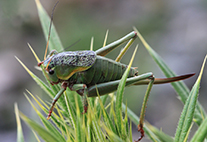Abstract
Psorodonotus (Orthoptera, Tettigoniidae) includes 11 species distributed in Caucasus, Anatolia and Balkans. Although its present taxonomy is problematic, mainly three species groups can be distinguished; (i) The Specularis Group, (ii) The Caucasicus Group and (iii) The Venosus Group. Our recent studies on the genus have revealed presence of two new species in the last species group. Morphology of the species group studied both qualitatively and quantitatively using linear metric data of pronotum, tegmina and hind femur, and geometric data of male cerci and ovipositor. Morphological data were accompanied by data obtained from male calling song. Morphological and song data were produced from six different populations from North and Eastern part of Turkey: (1) Hakkari, (2) Tendürek, (3) Giresun, (4) Artvin, (5) Kars and (6) Ağrı. Qualitative and quantitative morphology, either linear-metric or geometric, suggest last three population as members of the same unit, but each of other three as different units. Song data are also largely in support of the morphological results. Necessary illustrations were provided to document results visually. Following conclusions were made: (1) the Artvin, Kars and Ağrı populations represent typical P. venosus and the Giresun population P. rugulosus, (2) each of the Hakkari and Tendürek populations represents a new species and P. hakkari sp. n. and P. tendurek sp. n. described by comparing with other members of P. venosus group, (3) P. rugulosus, P. hakkari sp. n. and P. tendurek sp. n. differ from P. venosus mainly by the longer cerci (extend to or beyond end of abdomen) and indistinct tubercles on surface of pronotal disc in female. P. rugulosus and P. tendurek sp. n. are also similar by sharing presence of two loud elements in a syllable (one in P. venosus, song of P. hakkari sp. n. is not available). But, similarities in phenotype are in conflict with relationships suggested by genetic data.

